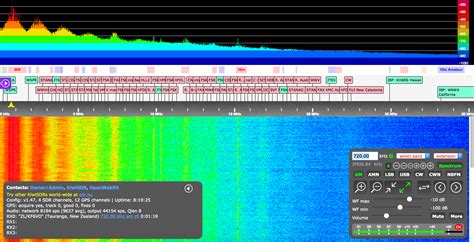Introduction to Kiwi SDR
Kiwi SDR is a software-defined radio (SDR) device that has revolutionized the way we explore and interact with radio frequencies. Developed by John Seamons, Kiwi SDR is an open-source project that allows users to access and control a remote SDR device through a web browser. This innovative technology has opened up new possibilities for radio enthusiasts, researchers, and hobbyists alike.
What is a Software-Defined Radio (SDR)?
Before diving into the specifics of Kiwi SDR, it’s essential to understand what a software-defined radio is. An SDR is a radio communication system where components traditionally implemented in hardware, such as filters, amplifiers, and modulators, are instead implemented using software on a computer or embedded system. This approach allows for greater flexibility, adaptability, and cost-effectiveness compared to traditional radio systems.
Key Features of Kiwi SDR
Kiwi SDR offers a wide range of features that make it a powerful and versatile tool for exploring the radio spectrum. Some of the key features include:
- Wide Frequency Coverage: Kiwi SDR covers a broad frequency range, typically from 10 kHz to 30 MHz, which includes popular bands such as AM, FM, shortwave, and more.
- Web-Based Interface: Users can access and control Kiwi SDR through a web browser, making it accessible from any device with an internet connection.
- Open-Source Software: The Kiwi SDR software is open-source, allowing users to modify and customize it to suit their specific needs.
- Multiple Demodulators: Kiwi SDR supports various demodulators, including AM, FM, SSB, CW, and more, enabling users to listen to different types of radio signals.
- Waterfall Display: The waterfall display provides a visual representation of the radio spectrum, making it easier to identify and analyze signals.
- Recording and Playback: Users can record and playback radio signals for later analysis or sharing with others.
Setting Up and Using Kiwi SDR
Hardware Requirements
To set up a Kiwi SDR, you’ll need the following hardware components:
- BeagleBone Green or Black single-board computer
- Kiwi SDR cape (extension board)
- Antenna (depending on the frequency range you want to monitor)
- Power supply
- Ethernet cable
Software Installation
The Kiwi SDR software is pre-installed on the BeagleBone board, making the setup process relatively straightforward. However, if you need to update or reinstall the software, you can follow the official documentation provided by the Kiwi SDR project.
Accessing Kiwi SDR through a Web Browser
Once your Kiwi SDR is set up and connected to the internet, you can access it through a web browser by entering the device’s IP address. The web-based interface provides a user-friendly way to control the SDR, adjust settings, and explore the radio spectrum.
Applications of Kiwi SDR
Kiwi SDR has a wide range of applications across various fields, including:
- Amateur Radio: Kiwi SDR is a popular tool among amateur radio enthusiasts, allowing them to monitor and communicate with other ham radio operators worldwide.
- Scientific Research: Researchers can use Kiwi SDR to study radio phenomena, such as ionospheric propagation, solar flares, and more.
- Education: Kiwi SDR is an excellent educational tool for teaching students about radio communications, signal processing, and software-defined radio concepts.
- Spectrum Monitoring: Government agencies and organizations can use Kiwi SDR to monitor and analyze the radio spectrum for interference, illegal transmissions, and other anomalies.

Kiwi SDR Community and Resources
One of the strengths of Kiwi SDR is its active and supportive community. There are numerous resources available for users to learn, share, and collaborate with others, including:
- Official Kiwi SDR forums
- GitHub repository for the open-source software
- User guides and tutorials
- Online communities and social media groups
These resources provide a wealth of information and support for both beginners and experienced users of Kiwi SDR.
Frequently Asked Questions (FAQ)
-
What is the frequency range of Kiwi SDR?
Kiwi SDR typically covers a frequency range from 10 kHz to 30 MHz, which includes popular bands such as AM, FM, shortwave, and more. -
Can I use Kiwi SDR without an internet connection?
No, Kiwi SDR requires an internet connection to access and control the device through a web browser. -
Is Kiwi SDR open-source?
Yes, the Kiwi SDR software is open-source, allowing users to modify and customize it to suit their specific needs. -
What hardware components do I need to set up a Kiwi SDR?
To set up a Kiwi SDR, you’ll need a BeagleBone Green or Black single-board computer, a Kiwi SDR cape (extension board), an antenna, a power supply, and an Ethernet cable. -
Can I use Kiwi SDR for amateur radio communications?
Yes, Kiwi SDR is a popular tool among amateur radio enthusiasts, allowing them to monitor and communicate with other ham radio operators worldwide.
Conclusion
Kiwi SDR is a powerful and versatile software-defined radio device that has revolutionized the way we explore and interact with radio frequencies. Its wide frequency coverage, web-based interface, open-source software, and multiple demodulators make it an invaluable tool for radio enthusiasts, researchers, and hobbyists alike. With its active community and extensive resources, Kiwi SDR is accessible to users of all skill levels, from beginners to experts. As technology continues to advance, Kiwi SDR will undoubtedly remain a key player in the world of software-defined radio and beyond.






Leave a Reply